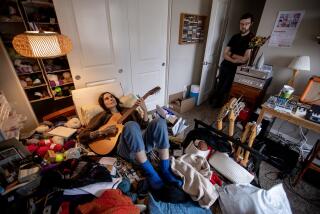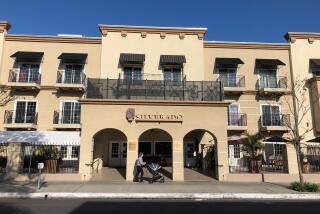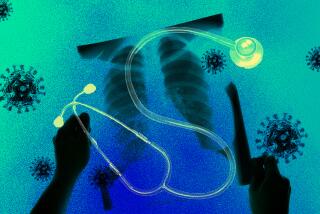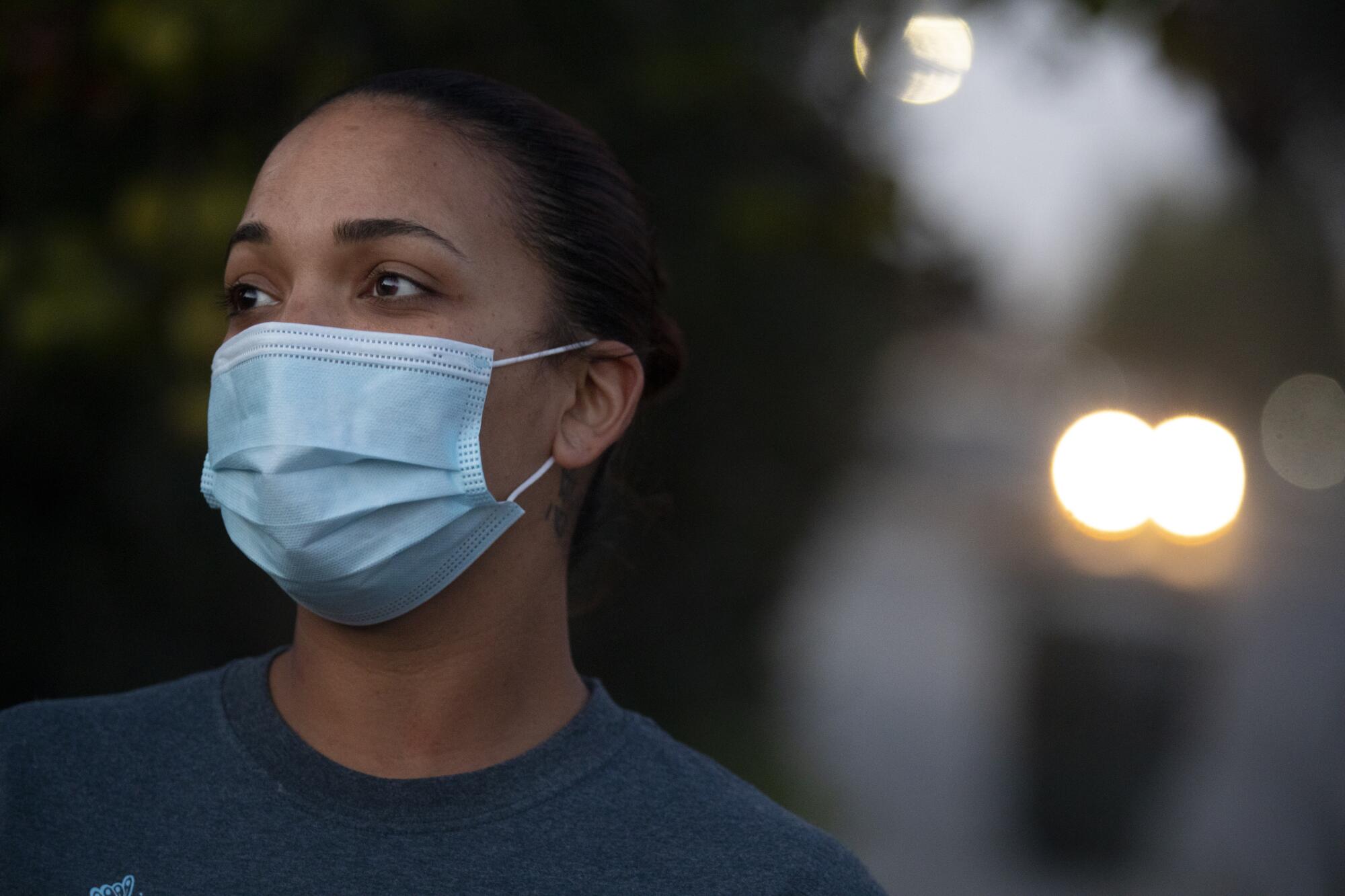
- Share via
BAKERSFIELD — Their faces flickered with hope when she entered their rooms.
“Did my daughter forget about me?” asked one woman, over 80 years old. “Does she know I’m here?”
“Where is my son?” begged a man down the hall.
Her answers always reeled them back into despondency.
Crystal Teal explained, as she did every morning, that because of the COVID-19 outbreak, visitors were not allowed. Teal, a licensed vocational nurse, would normally linger to cheer up her patients, chat about their families, joke around. But now every day was triage, a frantic door-to-door race to keep people alive.
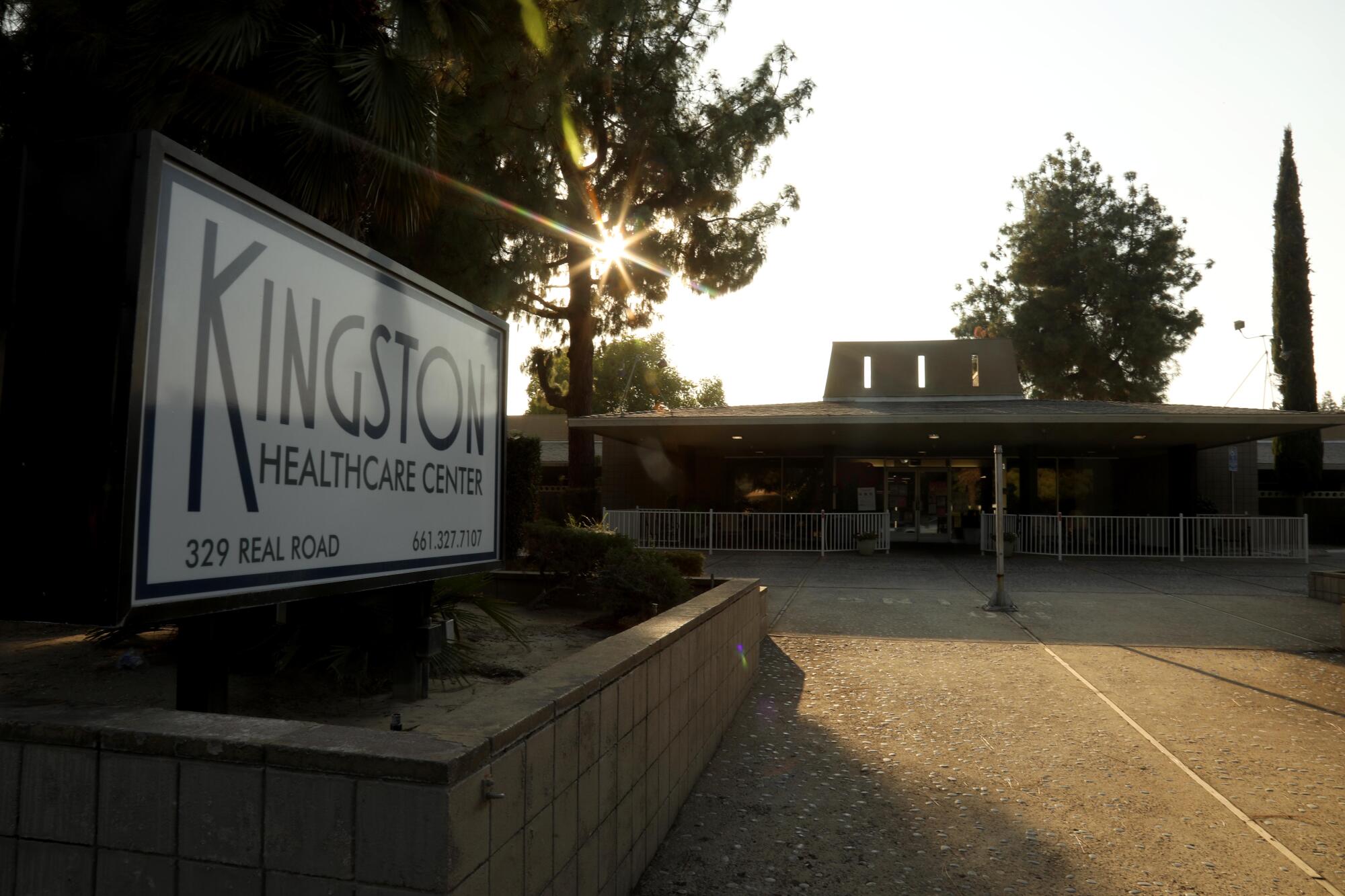
It was early May at Kingston Healthcare Center, a 184-bed skilled nursing facility in Bakersfield. In the wing where Teal worked, every single one of the 61 residents had COVID-19. So did most of the staffers, who largely stayed home, leaving Teal and one other nurse to take care of dozens of patients each.
Before this, the pair would have eight assistants for every shift. Now, on many days, they had zero. They had to enlist housekeepers and county paramedics to keep residents fed and cleaned. A number of patients were falling into catatonic depression, refusing to eat or drink. Infection control was grievously lacking. Deaths were mounting.
Every day after Teal finished her 12-hour shift, she sat in her car and sobbed.
No place has been hit harder by the pandemic than skilled nursing homes — and no front-line workers have been hit harder than the caregivers who staff them. In California facilities alone, COVID-19 has taken more than 8,200 lives, a third of all deaths from the disease statewide. As the virus ran rampant at one facility after another, the low-wage nurses and certified nursing assistants, or CNAs, were fighting the deadliest battle in the state while all but invisible to the outside world.
Few of the caregivers have dared speak out about the emotional and physical nightmare they were going through — much less about management bent on maintaining profits and cutting corners as things spun out of control. Denied critical information and protective gear they needed to avoid infection, they risked their lives as they were pilloried in the news and social media for killing the people they were paid to care for.
Health privacy laws further prohibited any facility from identifying who was infected, or even who died, keeping the human toll of each outbreak largely reduced to statistics.
The pandemic’s toll: Lives lost in California
Hundreds of people have died in California due to the COVID-19 pandemic. These are some of their stories.
The meltdown at Kingston — as recounted by Teal and a co-worker, Christina Lockyer — provides an intimate look at a catastrophe that replayed over and over in major nursing home chains throughout California.
The workers’ accounts are backed up by records from Cal/OSHA, the California Department of Public Health, Medicare and the Service Employees International Union Local 2015, as well as interviews with a resident and the mother of a resident who died. Union leaders say what occurred there is no anomaly.
“What happened at Kingston is unforgivable,” said Arnulfo De La Cruz, executive vice president of SEIU 2015. “And unfortunately, similar egregious behaviors with devastating outcomes have occurred across the state — especially at larger, corporate-run facilities.”
Eugenia Caldwell, a 54-year-old nurse, caught COVID-19 in October at Shandin Hills Behavioral Health Care in San Bernardino after, she said, another nurse was ordered to come to work even though she felt sick and her boyfriend had COVID. Caldwell had still not been fitted for her medical-grade N95 masks, she said. Within weeks, 52 residents and 21 staff members had caught the virus. Caldwell passed it on to her 58-year-old husband, who for a month struggled to breathe.
Shandin Hills’ administrators did not respond directly to Caldwell’s statement, but said the facility “is currently in compliance with 100% of employees fit tested.”
Caldwell blames them for putting profit over the lives of vulnerable residents and workers.
“They make sure they get their bonuses,” she said. “But they don’t worry about their employees and residents.”
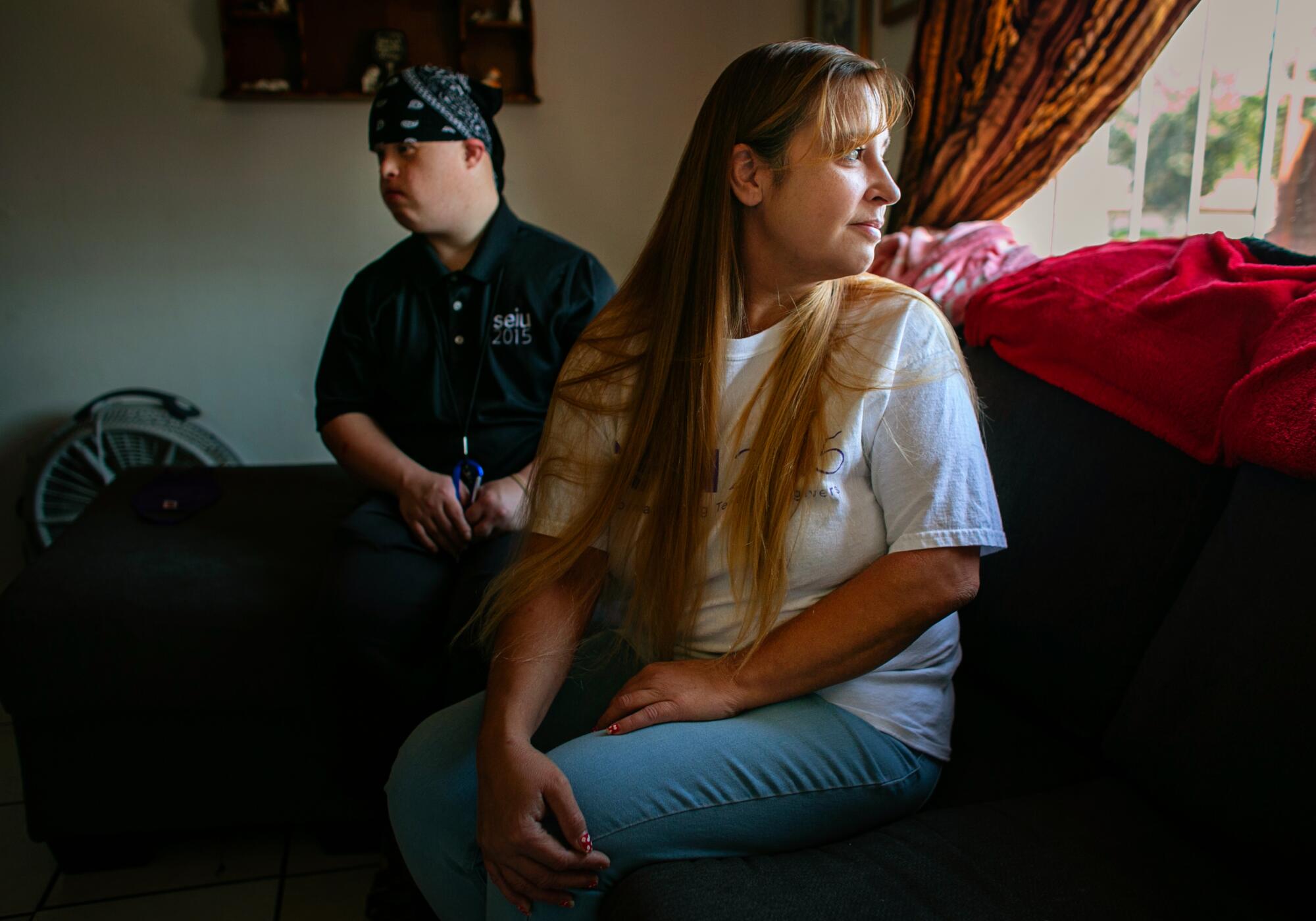
Christina Lockyer has worked as a certified nursing assistant at Kingston for 16 years. She earns $13.78 an hour, 78 cents above minimum wage.
Lockyer lives with her boyfriend and two sons, a 16-year-old and a 28-year-old who has Down syndrome. She rents one of the few three-bedroom apartments she can afford in Bakersfield, next to the Union Pacific tracks just north of the switching yard. It’s a hard part of town: In March, an 8-year-old girl in the apartment next door was bludgeoned to death, allegedly by her mom’s boyfriend. A few months later, a woman in the building was shot.
But Lockyer, 45, has a buoyant disposition. She delights in the human connection and sense of purpose at her work. She is unfazed by the sights and smells of bodily decline that she must clean up and salve. Her work is a calling. “I could work at Walmart and make more money,” she said.
Her friend Crystal Teal, 34, has that same feeling of mission. They both work the same wing of the three-wing facility.
Teal had six children by age 32, thwarting her childhood dreams of being a heart or brain surgeon. But she is deeply devoted to her career now, taking online courses at night to become a registered nurse with a bachelor’s degree, and, she hopes, a nurse practitioner someday.
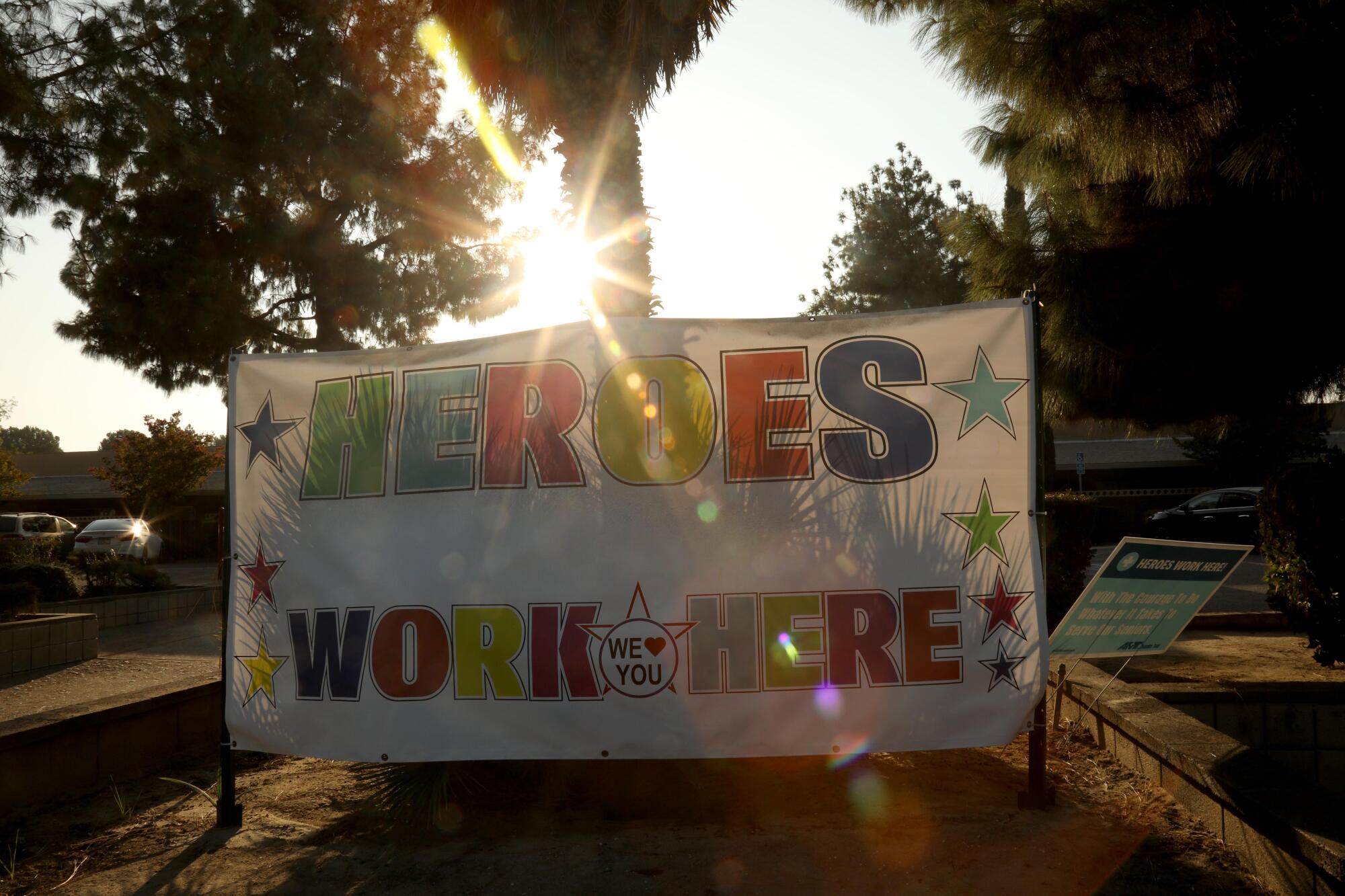
“Good morning, Papa,” she sings as she steps into one of her favorite resident’s rooms. He is well over 90, thin as a post, stubborn and fiercely independent. He walks around on his own, cleans himself and dresses himself as nattily as he can. He resists when she does anything for him that he feels he can do for himself. “No, no, no, I can do it,” he says.
But when she does it anyway, Papa always breaks sentimental: “I love you so much.”
“I know you do, come on now,” she says.
She buys him little presents now and then.
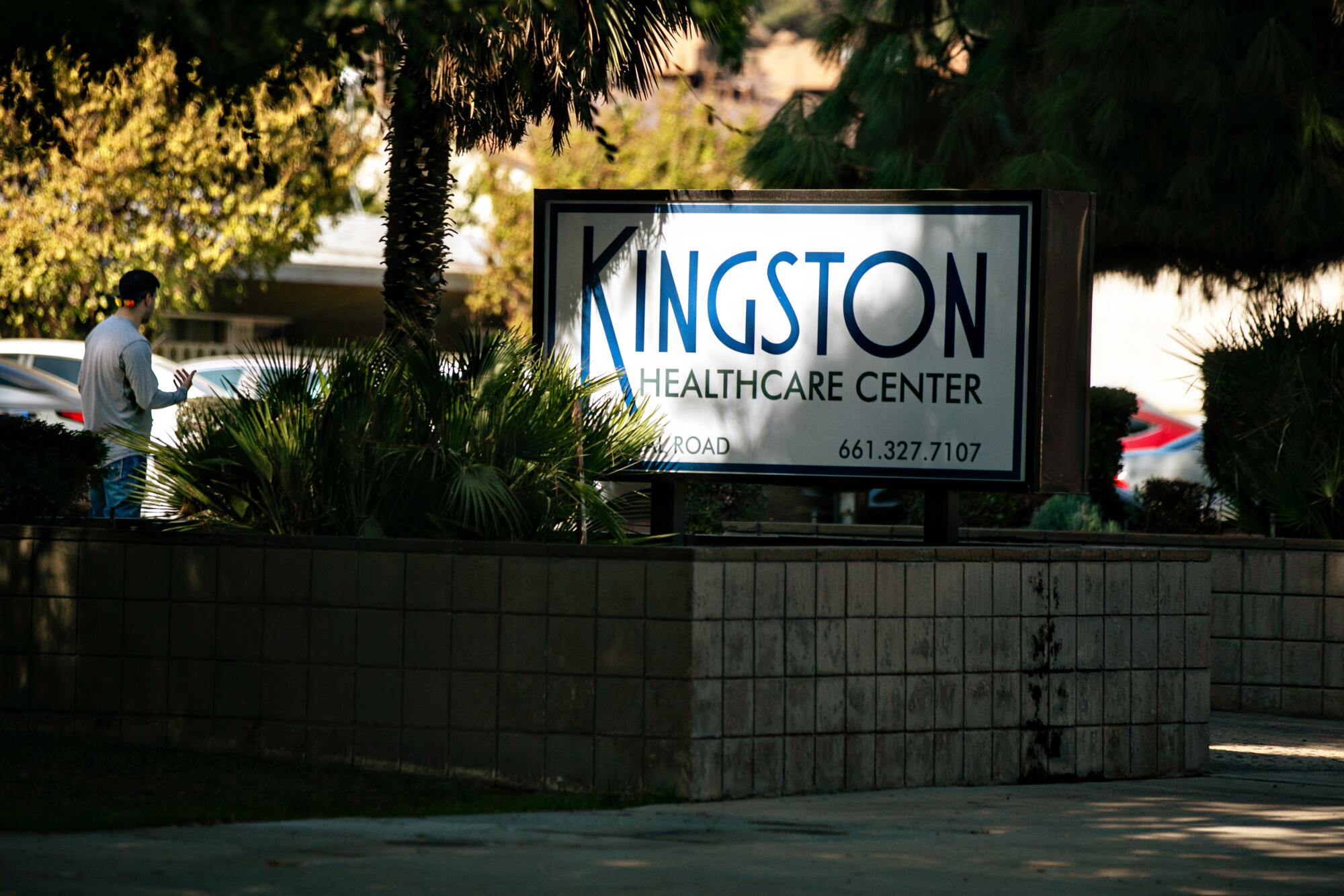
Ever since he was recently moved to another wing, he has moseyed on over to her nursing station every day to see her.
For these more lucid residents, Teal feels like part of their family — a realization that carries both joy and profound sadness. Since visits were stopped in March, this has become their entire world. She gets to go home every night.
For Lockyer, the relationship is even more fraught. She sees her father in these residents. Kenneth Lockyer, a retired supermarket butcher and vintage car tinkerer, has dementia and is in a skilled nursing facility in Los Angeles like this one. Once a month, before the pandemic, Christina drove over the Tejon Pass and brought him potato chips and a vintage Hot Wheels car that might get his memory churning and his mouth talking. It usually took until the end of the visit before he’d recognize her voice and realize, fleetingly, who she was.
She hasn’t seen him for nine months, and fears that the kernel of recognition might disappear forever.
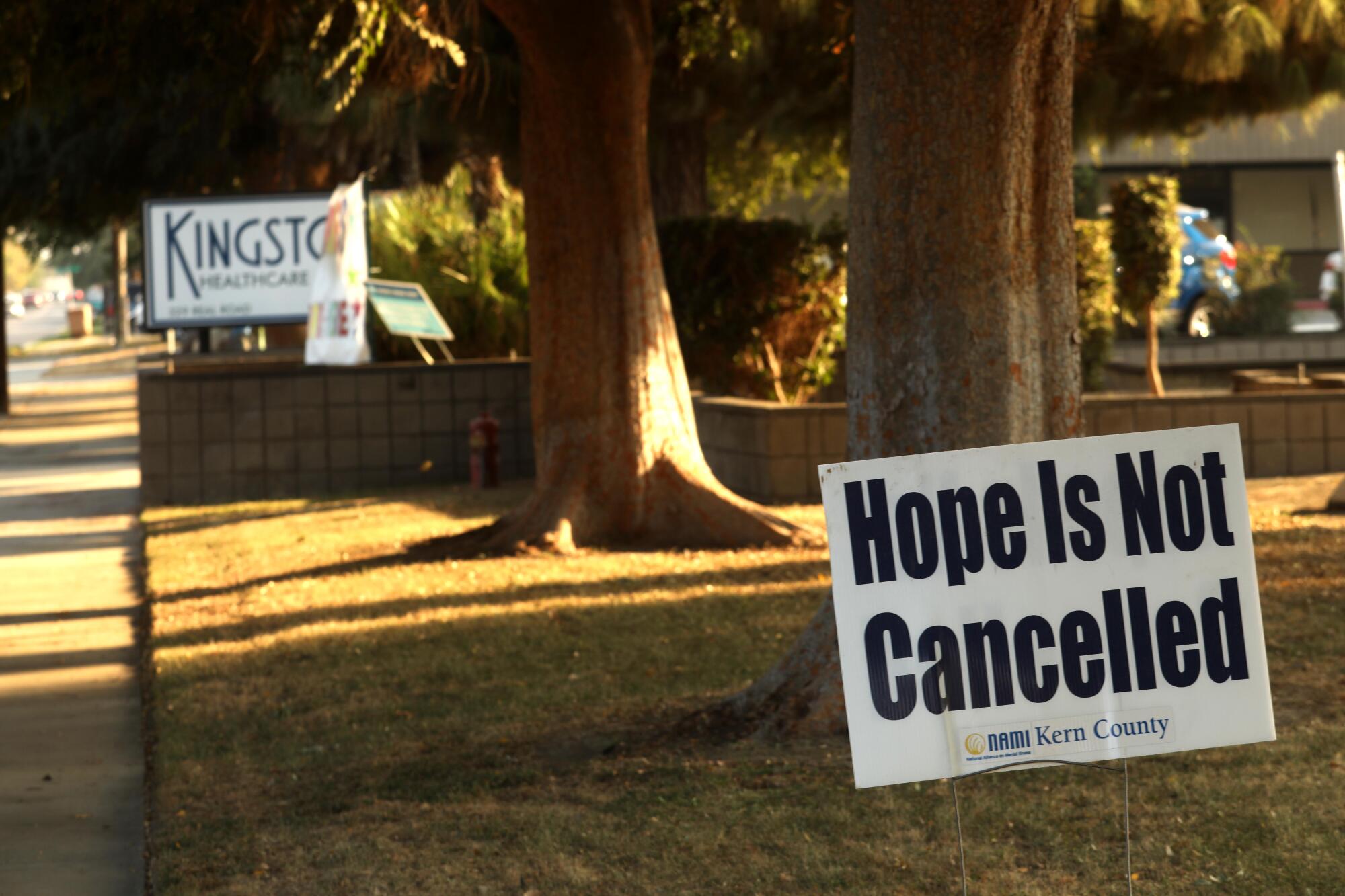
On April 17, a staff member at Kingston first tested positive for the coronavirus. Quickly, rumors were circulating that others, including residents, had tested positive.
At the end of their shifts, the caregivers gathered in the lobby to get answers from their bosses. They demanded to know who was sick. Lockyer, the union steward at Kingston, said they needed personal protective gear — masks, gowns and face shields. They asked for hazard pay. They wanted to get tested.
“Everybody is scared in this room,” Lockyer told a manager.
“You’re scared,” he replied — dismissively, in her view.
The workers got none of their demands. They had no way to know who might be spreading the disease to whom, how to avoid it or keep from giving it to anyone else.
“I think our facility’s biggest problem was at first they didn’t want to let people know we had positive people there,” Teal said. “So instead of stopping it in its tracks, we were spreading it around.”
Kingston Healthcare Center has a history of problems. Owned by a Beverly Hills rheumatologist, Dr. David Silver, Kingston is labeled a “special focus facility” by Medicare, a status reserved for its most problematic nursing homes. Of 1,230 long-term skilled nursing facilities in the state, only six have that designation.
In its last state healthcare inspection, in November 2019, it had 39 citations, about three times the average in California. The problems have ranged from small to serious: blinds and sliding glass doors not working, skin infections and dental problems not assessed properly. One man died when he fell and hit his head trying to go to the bathroom. The inspectors cited the “facility’s failure to implement their fall prevention policy” for the 86 residents at a high risk of falling.
Silver is also chief executive of Rockport Healthcare Services, which manages the largest chain of for-profit nursing homes in the state, operating 77 facilities in California and providing back office and clinical services at Kingston. He has touted Rockport’s role in creating six COVID treatment centers.
In October, Kingston — which months before had received $1.06 million in federal funds through the CARES Act — was hit with a $92,500 fine from Cal/OSHA for its poor handling of the spring outbreak. The major violations were for not implementing adequate measures to reduce disease transmission, not providing adequate protective gear to employees, and not informing employees about which co-workers and residents showed symptoms of infection, allowing the virus to spread.
Silver referred questions to Kingston’s administrator, Raj Desai, who said Kingston is appealing the Cal/OSHA citation and disputes all of its findings.
He said that when the first positive test came back, management immediately began testing residents and “took the initiative to send employees to off-site testing centers.”
“Anyone who may have been in contact with someone positive was notified,” Desai said. “And the staff members knew who was infected because the infected residents were cohorted in a separate area.”
The numbers don’t speak to such quarantining: 104 residents ultimately got sick, along with 87 employees.
By April 25, fear was running rampant with the virus, and many caregivers were not showing up to work. Administrators agreed to offer $3 an hour extra hazard pay to lure them back. That morning, Lockyer and her best friend and co-worker Gloria went to an urgent care to get tested. Gloria received her results the following day: Positive.
Lockyer descended into a spiral of fear. She must have the virus too, she thought. She and Gloria worked side by side every day, exposed to the same patients and co-workers. They even drove together to get tested, without masks. What if Lockyer passed it to her developmentally disabled son? He’d be taken to a hospital, alone, where he wouldn’t be able to understand what was happening. He had the cognition of a 5-year-old. He would think she abandoned him.
She couldn’t sleep, her mind whirling through every terrible possibility.
Three days later, Lockyer’s test came back negative.
She knew work needed her, even though she was scared to go back.
Teal had stayed on and moved into a friend’s vacant apartment so she didn’t expose her children and husband to the virus.
She was elated to see Lockyer return. Most of the staff and management had disappeared; many were very sick. She and her partner, Glenn, were the only nurses for the 61 residents in their wing. They desperately needed their team of nursing assistants back.
The facility had received some plastic gowns, face shields and N-95 masks from the county health department. The gowns were like a trash bag with sleeves and left workers drenched in sweat throughout their shift. They figured that masks must have been in short supply, because supervisors told them to reuse them for up to four shifts. The N-95s quickly smelled terrible, the odor of a wet dog in a hot car. Lockyer threatened to walk out if she didn’t get a new one every day. The nursing supervisor agreed.
But after four days, Lockyer decided she couldn’t take the risks. Infection was still spreading, and she knew she would get it if she stayed.
“You’re picking up every bodily fluid whether you’re blowing their nose or cleaning up diarrhea,” she said.
She went to her family doctor, described her exposure and took his recommendation to quarantine at home for two weeks, using up her entire year’s vacation time.
Teal and Glenn made a pact to keep working. If they left, the last familiar faces would vanish for many patients. They’d lose all hope.
The housekeeping staff stepped in to help, changing diapers, feeding and bathing, rolling people over in bed. As the crisis worsened, the California Department of Public Health sent a “strike team” of infection-control specialists to Kingston to establish protocols to stop transmission of the virus. The state also dispatched county paramedics to fill in for staff and distribute loads of personal protective gear, including thousands of N95 masks. All the help was desperately needed.
The paramedics saved the outbreak from becoming even more disastrous. But they had different skills than the nursing staff; they weren’t there to comfort a bewildered widow or grandfather. And they were outfitted with full-body hazmat-type suits and respirators that made the interactions more alien and terrifying.
News vans were parked outside Kingston. Teal saw on television that her facility was responsible for half the COVID cases in the county. State inspectors came every day with improvised rules for quarantining the COVID-positive patients. She thought the process was chaotic at first, and the tests were unreliable.
“Everyone is being exposed because literally every day we’re moving residents between A, B, and C wing because the state is telling us how we should rearrange the building,” Teal said. “We’re locking off sections one day. Three days later, we’re unlocking them. This side is positive. This side is negative. This side is observation. ... You got CNAs floating from other sections. There was so much confusion.”
Teal’s wing ultimately became “the red zone,” where the bulk of COVID patients were placed.
Lisa Bennink, 61, came to Kingston in March to rehabilitate her legs after six weeks in a hospital bed battling heart problems. She said she was moved from room to room, with different roommates in different wings, even after she tested positive for the coronavirus — and no one monitored who came and went through the clear plastic doors sealing off the infected areas.
“People with dementia and Alzheimer’s would unzip it and go on in,” she said.
Laura Ehlers called Kingston on May 7 to find out how her mother, Francia Hernandez, was doing. She was told her mother did not have COVID but, upon further questioning, that her mother’s roommate did.
“Can’t you move her to another room?” she asked.
“That’s not possible,” she was told.
Ehlers — a senior researcher for the the National Academies of Sciences, Engineering, and Medicine, who lives in Boston — provided The Times a text she sent to a friend that day: “I spoke to my mom’s nurse today. They say she is fine. ... But, she is sharing a room with someone who has it. This is distressing but they have no other options given the high number of infected patients.”
Desai, the administrator, said this did not happen: “We reviewed all of our records and at no time were any COVID-positive residents allowed to be in rooms with COVID-negative residents.” He added that he could not be more specific because of health privacy laws.
Hernandez’s health records show she was not moved from her room even as it became part of the red zone.
The next update Ehlers received about her mom was on May 16, when she got a call from a Bakersfield emergency room. Hernandez was struggling to breathe, with severe COVID. She died less than 30 hours later.
Paramedics were wheeling ever more residents out the back entrance to waiting ambulances. Teal was particularly worried about one of her favorites, a husky man who was having a hard time breathing. In normal times, he knew every nurse and assistant by name and constantly called out for things he could do himself. “Crystal, can you hand me my remote. ... Crystal, can you get me some water?”
He watched QVC all day. When she guided his wheelchair, she told him she needed him to help push the wheels. He said he couldn’t. But he put his arms through the motions, and the truth was, she was never pushing at all.
Now he asked her every time she left his room: “Are you coming back tomorrow?”
“Of course,” she promised.
After working 12 or 14 hours each day, she drove back to her empty apartment, stuffed her clothes into a plastic bag, showered vigorously, cleaned her nasal passages with a neti pot and tried to do some homework for her bachelor’s program.
Teal said her husband, a union pipe welder whose work dried up during the pandemic, didn’t understand why she kept going in.
“You can get unemployment and make more money,” he said. Her children wanted her to come home too. She missed them dearly and was worried about her 4-year-old boy, who had asthma, and her 2-year-old son, who needed respiratory treatments. No one understood.
“Kids want to talk to you,” her husband would say on the phone.
Then one would get on to complain about his cooking or say they’d “been eating McDonald’s for three days.”
Teal never felt so torn apart for doing her job.
In news and social media, it seemed as if the nurses were blamed for the outbreak. Teal heard a comment secondhand from a friend about her being one of the nurses “killing all those people.”
At work, as caregivers trickled back in, she began hearing about the fates of other co-workers. One CNA spread the disease to her parents, who were both in intensive care. Another worker was on a ventilator.
Lockyer’s friend Gloria recovered and returned to work. In the COVID unit, hazard pay had been bumped up to $7 an hour on top of regular wages. Lockyer came back May 14.
The outbreak was still churning through the building.
One morning, Teal arrived at the nursing station to get the update from the night nurse:
There had been a death: her QVC-watching friend. He had been calling out Teal’s name all night before he passed.
Teal worked 28 straight days through the worst part of the outbreak, followed by a day off, then two more weeks on the job before her next break. Teal was tested for the first time in early July, she said, and was positive. By the time she learned, she was already on her back with a splitting headache. She barely moved for four days, couldn’t eat and lost 13 pounds.
When she recovered, she went back to work. The resident she called Papa paid his visit from another wing and lighted up with excitement.
“Oh my God, I thought you were never coming back,” he said. “I thought you forgot about me.”
She teared up at all this implied: his loneliness, her burden.
In the end, 19 of the residents who caught COVID died and all employees survived. Many recovered with no major problems; others will never be the same.
Teal heard that the CNA who was on a ventilator is now living in a skilled nursing home herself.
Kingston had revoked the workers’ hazard pay on June 16. The next day, many signed a union petition to reinstate it. Desai said that hazard pay lasted for a full two months after the last positive test on May 15. The nurses say that’s not true; Why would they sign a petition if it was?
Teal separated from her husband shortly after the outbreak ended in summer. He couldn’t understand her commitment to the job. They finalized their divorce in November.
This month, Teal asked Papa what he wanted for Christmas.
“No, don’t get me anything.”
“I know what I’m going to get you,” she said.
“I don’t want a gift.”
“Suspenders,” she said. He could barely keep his pants up.
The next day he sidled up next to her in the hall. He’d been rethinking. “When you get me those, make sure they have the clip on the front and the back.”
More to Read
Sign up for Essential California
The most important California stories and recommendations in your inbox every morning.
You may occasionally receive promotional content from the Los Angeles Times.
